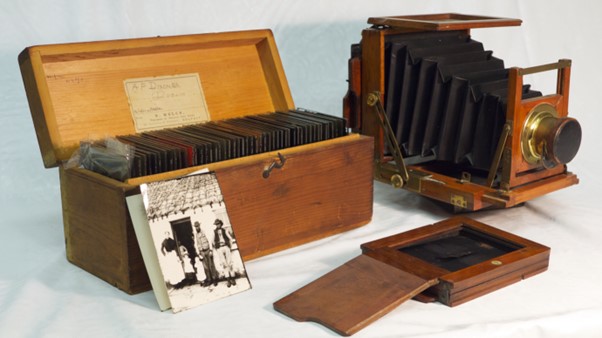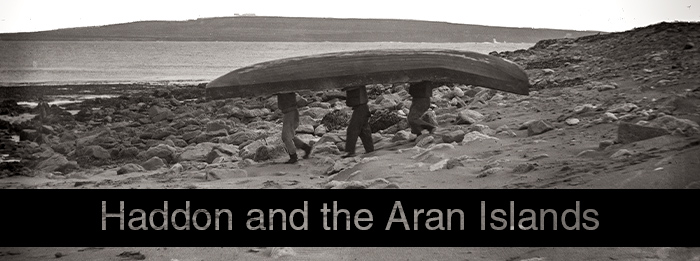
Alfred Cort Haddon and Andrew Francis Dixon spent a week in the Aran Islands in 1890. They documented the glacio-karst landscape, the people, their mode of life, beliefs, customs, folklore and numerous archaeological sites. Haddon summarised the work as follows:
I can’t tell you all the excursions we made in Aran. it wd be as tedious for you to read as for me to write suffice it to say that Dixon & I left very little unseen & what with sketches & photographs we have a good deal on paper.
Haddon, 1890, S.S. Fingal Journal: 50.
On his return to Dublin he used ten of Dixon’s photographs in a slideshow titled ‘The Aran Islands’, the first of a series that included ‘Ethnographical Studies in the West of Ireland’ in the Anthropological Institute in 1894 and ‘On the People of Western Ireland and their Mode of Life’ at a meeting of Section H–Anthropology later in the same year. This exhibition is organised around the first slideshow and develops ideas explored in Alfred Cort Haddon: A Very English Savage. The photographs were reproduced from digital scans of the original negatives and first generation prints, most of which are exhibited for the first time.
The social documentary quality and archaeological focus of ‘The Aran Islands’ slideshow disrupts the prevailing association between photography in anthropology and the scientific racism materialised in anthropometric portraits from the same era, which Andrei Nacu explored in his ‘Grid’ exhibition in the RAI in September 2023. Haddon intended to be disruptive. He had no interest in physical anthropology. His slideshow was a synthetic study of place-work-folk, a formula Patrick Geddes adapted from the social survey model Frédéric le Play developed in France. This sociological framing of his ethnography inaugurated a formal opposition between ‘instantaneous’ or social documentary photography and what Haddon, writing in a photo-ethnographic manifesto in the 1912 edition of Notes and Queries on Anthropology, called the ‘stiff profiles required by the anatomist’ (Haddon 1912, 270). As brief as it is, this statement matters for two reasons. One, it registered Haddon’s long battle with the anatomists who dominated anthropology in the 1890s. Two, it expressed his commitment to visual anthropology as a sociologically oriented alternative to physical anthropology and, as such, an ethnographic vehicle for anti-colonialism activism.
Sure, Haddon engaged in skull measuring in a mobile version of Francis Galton’s anthropometric laboratory when he returned to the Aran Islands in 1892. He also produced ‘stiff portraits’ as he tried to establish himself in a field dominated by Galton and his associates, including Alexander Macalister, Professor of Anatomy at Cambridge and President of the Anthropological institute from 1893 to 1894. In 1893, Macalister employed Haddon as a part-time lecturer in physical anthropology and, in 1895, they managed an ethnographic survey in the village of Barley. Haddon took photographs following guidelines Galton drew up for the UK Ethnographic Survey.
The contrast with ‘The Aran Islands’ slideshow couldn’t be starker and that situates Haddon’s experiment in a wider struggle between ‘culturals’ and ‘physicals’ – as E. B. Tylor (1893) labelled them – for control of anthropology. Despite his ‘anthropometric’ associations Haddon was a ‘cultural’. Anthropometric portraits play little or no part in the slideshows he performed between 1890 and 1895. Instead, the slideshows document the study of folk, their customs, beliefs, art and dance across time and space, culminating in experiments in colour photography and ethnographic filmmaking in the Torres Strait in 1898.
These experiments are signposted here with digital prints of the oldest surviving photograph of Skellig Michael (1868) and a copy Haddon made in 1890, a study of folk dance by Clara Patterson (1893) and a still from Haddon’s film of the last dance of the Malu Zogo-Le (1898). John Millington Synge followed Haddon to the Aran Islands in 1898 and is represented by a photograph that registers Haddon’s influence on literary modernism and cultural nationalism in Ireland in the 1890s, which, in turn, indexes Haddon’s modernism.
In sum, ‘The Aran Islands’ slideshow marks the beginning of a form of anthropology that we would recognise today as visual anthropology. Unfortunately for Haddon, his photo-ethnographic manifesto entered the modern era just as anthropology was becoming what Margaret Mead called ‘a discipline of words’. Furthermore, a historiographical focus on Haddon’s career in zoology obscured his interest in art and photography and so masked the beginning of visual anthropology.
Ciarán Walsh
September 2023
Manuscripts
Haddon, A. C.
———. 1890. S.S. Fingal Journal (Aran Islands), pp. 40–50 (Haddon Library File 88.H).
———. 1890. ‘The Aran Islands’ slideshow commentary (Haddon Library File P.88.H).
Other references
Haddon, A. C, 1912. ‘Appendix: Photography’ in Notes and Queries on Anthropology (4th edn) edited by J. L. Myres and B. W. Freire-Marreco, 267–71. London: Harris.
Tylor, E. B. 1893. ‘Anniversary Address,’ JAI 22: 376–85.

